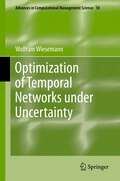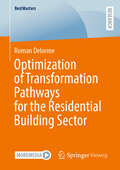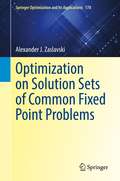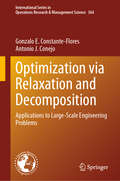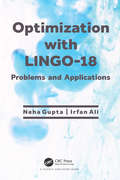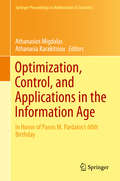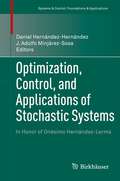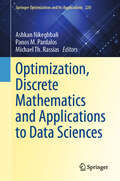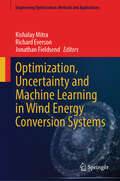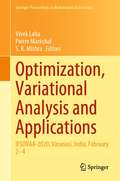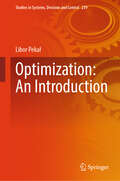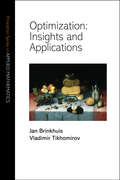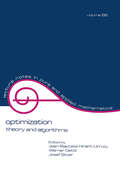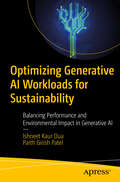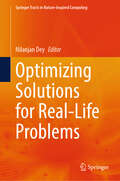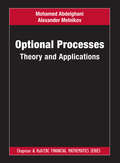- Table View
- List View
Optimization of Structures and Components
by Pablo Andrés Muñoz-RojasWritten by an international group of active researchers in the field, this volume presents innovative formulations and applied procedures for sensitivity analysis and structural design optimization. Eight chapters discuss subjects ranging from recent developments in the determination and application of topological gradients, to the use of evolutionary algorithms and meta-models to solve practical engineering problems. With such a comprehensive set of contributions, the book is a valuable source of information for graduate students and researchers entering or working in the matter.
Optimization of Temporal Networks under Uncertainty
by Wolfram WiesemannMany decision problems in Operations Research are defined on temporal networks, that is, workflows of time-consuming tasks whose processing order is constrained by precedence relations. For example, temporal networks are used to model projects, computer applications, digital circuits and production processes. Optimization problems arise in temporal networks when a decision maker wishes to determine a temporal arrangement of the tasks and/or a resource assignment that optimizes some network characteristic (e.g. the time required to complete all tasks). The parameters of these optimization problems (e.g. the task durations) are typically unknown at the time the decision problem arises. This monograph investigates solution techniques for optimization problems in temporal networks that explicitly account for this parameter uncertainty. We study several formulations, each of which requires different information about the uncertain problem parameters.
Optimization of Transformation Pathways for the Residential Building Sector (BestMasters)
by Roman DelormeThe German residential building sector plays a crucial role in achieving net greenhouse gas neutrality by 2045. However, current renovation rates remain insufficient to meet climate targets. To improve the efficiency of the sector&’s transformation, transformation pathways can be utilized, providing plans that specify renovation actions, timings, and locations. Despite their potential, existing literature lacks holistic and exact optimization frameworks for determining such pathways. To address this gap, the author introduces a problem formulation and a MILP model to optimize transformation pathways for residential building stocks. To accelerate the solution process, he explores multiple Benders decompositions of the original MILP model. Additionally, he implements acceleration techniques, including constraint modifications, valid inequalities, strengthened Benders optimality cuts, a construction heuristic, and an in-out method. The Benders cut separation process is integrated into Gurobi&’s branch-and-cut algorithm. About the author Roman Delorme holds master&’s degrees in Energy Engineering and in Management, Business, and Economics from RWTH Aachen University, Germany. He is currently a research associate at the university's Chair of Operations Research, where he focuses on developing and refining solution methods for mixed-integer optimization models in the context of energy-related challenges.
Optimization on Solution Sets of Common Fixed Point Problems (Springer Optimization and Its Applications #178)
by Alexander J. ZaslavskiThis book is devoted to a detailed study of the subgradient projection method and its variants for convex optimization problems over the solution sets of common fixed point problems and convex feasibility problems. These optimization problems are investigated to determine good solutions obtained by different versions of the subgradient projection algorithm in the presence of sufficiently small computational errors. The use of selected algorithms is highlighted including the Cimmino type subgradient, the iterative subgradient, and the dynamic string-averaging subgradient. All results presented are new. Optimization problems where the underlying constraints are the solution sets of other problems, frequently occur in applied mathematics. The reader should not miss the section in Chapter 1 which considers some examples arising in the real world applications. The problems discussed have an important impact in optimization theory as well. The book will be useful for researches interested in the optimization theory and its applications.
Optimization via Relaxation and Decomposition: Applications to Large-Scale Engineering Problems (International Series in Operations Research & Management Science #364)
by Antonio J. Conejo Gonzalo E. Constante-FloresThis book offers an up-to-date description of relaxation/approximation and decomposition techniques, demonstrating how their combined use efficiently solves large-scale optimization problems relevant to engineering, particularly in electrical, and industrial engineering, with a focus on energy. Specifically, it presents linear and nonlinear relaxations and approximations that are relevant to optimization problems, introduces complicating constraints and complicating variables decomposition techniques that can take advantage of relaxations and approximations, and examines their applications in the engineering field. Written in an accessible engineering language and filled with numerous illustrative examples and end-of-chapter exercises for all chapters, this book is a valuable resource for advanced undergraduate and graduate students, researchers, and practitioners in power engineering and industrial engineering. Moreover, business students with a keen interest in decision-making problems will also benefit greatly from its practical insights.
Optimization with LINGO-18: Problems and Applications
by Irfan Ali Neha GuptaThis book presents fundamental concepts of optimization problems and its real-world applications in various fields. The core concepts of optimization, formulations and solution procedures of various real-world problems are provided in an easy-to-read manner. The unique feature of this book is that it presents unified knowledge of the modelling of real-world decision-making problems and provides the solution procedure using the appropriate optimization techniques. The book will help students, researchers, and faculty members to understand the need for optimization techniques for obtaining optimal solution for the decision-making problems. It provides a sound knowledge of modelling of real-world problems using optimization techniques. It is a valuable compendium of several optimization techniques for solving real-world application problems using optimization software LINGO. The book is useful for academicians, practitioners, students and researchers in the field of OR. It is written in simple language with a detailed explanation of the core concepts of optimization techniques. Readers of this book will understand the formulation of real-world problems and their solution procedures obtained using the appropriate optimization techniques.
Optimization with PDE Constraints
by Ronald HoppeThis book on PDE Constrained Optimization contains contributions on the mathematical analysis and numerical solution of constrained optimal control and optimization problems where a partial differential equation (PDE) or a system of PDEs appears as an essential part of the constraints. The appropriate treatment of such problems requires a fundamental understanding of the subtle interplay between optimization in function spaces and numerical discretization techniques and relies on advanced methodologies from the theory of PDEs and numerical analysis as well as scientific computing. The contributions reflect the work of the European Science Foundation Networking Programme 'Optimization with PDEs' (OPTPDE).
Optimization, Control, and Applications in the Information Age
by Athanasia Karakitsiou Athanasios MigdalasRecent developments in theory, algorithms, and applications in optimization and control are discussed in this proceedings, based on selected talks from the 'Optimization Control and Applications in the Information Age' conference, organized in honor of Panos Pardalos's 60th birthday. This volume contains numerous applications to optimal decision making in energy production and fuel management, data mining, logistics, supply chain management, market network analysis, risk analysis, and community network analysis. In addition, a short biography is included describing Dr. Pardalos's path from a shepherd village on the high mountains of Thessaly to academic success. Due to the wide range of topics such as global optimization, combinatorial optimization, game theory, stochastics and programming contained in this publication, scientists, researchers, and students in optimization, operations research, analytics, mathematics and computer science will be interested in this volume.
Optimization, Control, and Applications of Stochastic Systems
by J. Adolfo Minjárez-Sosa Daniel Hernández-HernándezThis volume provides a general overview of discrete- and continuous-time Markov control processes and stochastic games, along with a look at the range of applications of stochastic control and some of its recent theoretical developments. These topics include various aspects of dynamic programming, approximation algorithms, and infinite-dimensional linear programming. In all, the work comprises 18 carefully selected papers written by experts in their respective fields. Optimization, Control, and Applications of Stochastic Systems will be a valuable resource for all practitioners, researchers, and professionals in applied mathematics and operations research who work in the areas of stochastic control, mathematical finance, queueing theory, and inventory systems. It may also serve as a supplemental text for graduate courses in optimal control and dynamic games.
Optimization, Discrete Mathematics and Applications to Data Sciences (Springer Optimization and Its Applications #220)
by Panos M. Pardalos Michael Th. Rassias Ashkan NikeghbaliThis book delves into the dynamic intersection of optimization and discrete mathematics, offering a comprehensive exploration of their applications in data sciences. Through a collection of high-quality papers, readers will gain insights into cutting-edge research and methodologies that address complex problems across a wide array of topics. The chapters cover an impressive range of subjects, including advances in the study of polynomials, combinatorial identities, and global optimization algorithms. Readers will encounter innovative approaches to predictive models for non-performing loans, rainbow greedy matching algorithms, and the cost of detection in interaction testing. The book also examines critical issues such as demand aggregation, mid-term energy planning, and minimum-cost energy flow. Contributions from expert authors provide a deep dive into multilevel low-rank matrices, the protection of medical image authenticity, and the mathematical intricacies of the Braess paradox. This volume invites readers to explore diverse perspectives and theoretical insights that are both practical and forward-thinking. This publication is an invaluable resource for graduate students and advanced researchers in the fields of optimization and discrete mathematics. It is particularly beneficial for those interested in their applications within data sciences. Academics across these disciplines will find the book's content relevant to their work, while practitioners seeking to apply these concepts in industry will appreciate its practical case studies. Whether you are a scholar or a professional, this book offers a wealth of knowledge that bridges theory with real-world applications.
Optimization, Simulation and Control: ICOSC 2022, Ulaanbaatar, Mongolia, June 20–22 (Springer Proceedings in Mathematics & Statistics #434)
by Panos M. Pardalos Altannar Chinchuluun Rentsen EnkhbatThis volume gathers selected, peer-reviewed works presented at the 7th International Conference on Optimization, Simulation and Control, ICOSC 2022, held at the National University of Mongolia, Ulaanbaatar, June 20–22, 2022. Topics covered include (but are not limited to) mathematical programming; network, global, linear, nonlinear, parametric, stochastic, and multi-objective optimization; control theory; biomathematics; and deep and machine learning, to name a few. Held every three years since 2002, the ICOSC conference has become a traditional gathering for experienced and young researchers in optimization and control to share recent findings in these fields and discuss novel applications in myriad sectors. Researchers and graduate students in the fields of mathematics, engineering, and computer science can greatly benefit from this book, which can also be enjoyed by advanced practitioners in research laboratories and the industry. The 2022 edition of the ICOSC conference was sponsored by the Mongolian Academy of Sciences, the National University of Mongolia and the German-Mongolian Institute for Resources and Technology.
Optimization, Uncertainty and Machine Learning in Wind Energy Conversion Systems (Engineering Optimization: Methods and Applications)
by Richard Everson Kishalay Mitra Jonathan FieldsendThis book presents state-of-the-art technologies in wind farm layout optimization and control to improve the current industry/research practice. The contents take readers towards a different kind of uncertainty handling through the discussion on several techniques enabling maximum energy harnessing out of uncertain situations. The book aims to give a detailed overview of such concepts in the first part, where the recent advancements in the fields of (i) Wind farm layout optimization, (ii) Multi-objective Optimization and Uncertainty handling in optimization methods, (iii) Development of Machine Learning-based surrogate models in optimization, and (iv) Different types of wake models for wind farms will be discussed. The second part will cover the application of the aforementioned techniques on the wind farm layout optimization and control through several chapters such as (i) Wind farm performance assessment using Computational Fluid Dynamics (CFD) tools, (ii) Artificial Neural Network (ANN) based hybrid wake models, (iii) Long Short-term Memory (LSTM) & Support Vector Regression (SVR) based forecasting and micro-siting, (iv) windfarm micro-siting using data-driven Robust Optimization (RO) as well as Generative Adversarial Networks (GANs), (v) Reinforcement learning (RL) based wind farm control and (vi) Application of eXplainable AI (XAI) tools for interpreting wind time-series data. In this manner, the book provides state-of-the-art techniques in the fields of multi-objective optimization, Evolutionary Algorithms, Machine Learning surrogate models, Bayesian Optimization, Data Analysis, and Optimization under Uncertainty and their applications in the field of wind energy generation that can be extremely generic and can be applied to many other engineering fields. This volume will be of interest to those in academia and industry.
Optimization, Variational Analysis and Applications: IFSOVAA-2020, Varanasi, India, February 2–4 (Springer Proceedings in Mathematics & Statistics #355)
by S. K. Mishra Vivek Laha Pierre MaréchalThis book includes selected papers presented at the Indo-French Seminar on Optimization, Variational Analysis and Applications (IFSOVAA-2020), held at the Department of Mathematics, Institute of Science, Banaras Hindu University, Varanasi, India, from 2–4 February 2020. The book discusses current optimization problems and their solutions by using the powerful tool of variational analysis. Topics covered in this volume include set optimization, multiobjective optimization, mathematical programs with complementary, equilibrium, vanishing and switching constraints, copositive optimization, interval-valued optimization, sequential quadratic programming, bound-constrained optimization, variational inequalities, and more. Several applications in different branches of applied mathematics, engineering, economics, finance, and medical sciences have been included. Each chapter not only provides a detailed survey of the topic but also builds systematic theories and suitable algorithms to deduce the most recent findings in literature. This volume appeals to graduate students as well as researchers and practitioners in pure and applied mathematics and related fields that make use of variational analysis in solving optimization problems.
Optimization: 100 Examples
by Simon SerovajskyOptimization: 100 Examples is a book devoted to the analysis of scenarios for which the use of well-known optimization methods encounter certain difficulties. Analysing such examples allows a deeper understanding of the features of these optimization methods, including the limits of their applicability. In this way, the book seeks to stimulate further development and understanding of the theory of optimal control. The study of the presented examples makes it possible to more effectively diagnose problems that arise in the practical solution of optimal control problems, and to find ways to overcome the difficulties that have arisen. Features Vast collection of examples Simple. accessible presentation Suitable as a research reference for anyone with an interest in optimization and optimal control theory, including mathematicians and engineers Examples differ in properties, i.e. each effect for each class of problems is illustrated by a unique example. Simon Serovajsky is a professor of mathematics at Al-Farabi Kazakh National University in Kazakhstan. He is the author of many books published in the area of optimization and optimal control theory, mathematical physics, mathematical modelling, philosophy and history of mathematics as well as a long list of high-quality publications in learned journals.
Optimization: Algorithms and Applications
by Rajesh Kumar AroraChoose the Correct Solution Method for Your Optimization ProblemOptimization: Algorithms and Applications presents a variety of solution techniques for optimization problems, emphasizing concepts rather than rigorous mathematical details and proofs. The book covers both gradient and stochastic methods as solution techniques for unconstrained and co
Optimization: An Introduction (Studies in Systems, Decision and Control #239)
by Libor PekařThis book covers analytic methods to solve one-dimensional and multi-dimensional problems with or without possible constraints, iterative numerical techniques based on the gradient calculation or its estimation, and numerical methods that do not require the knowledge of gradient and use only comparative iterative tests. This book provides the reader with a basic introduction to some traditional parameter optimization techniques. The presented problems and their solution methods represent a core of the parameter optimization reign since the 17th century to the 1970s. Linear and integer programming via the simplex table is also introduced. Two simple selected problems that are solved using dynamic programming principles are also given to the reader. A general approach to constraints via penalty and barrier functions is introduced. A concise introduction to the decision and game theory concludes the book. The book does not intend to provide the reader with a rigorous mathematic derivation of the presented methods. Its aim is instead to bring to the attention essential optimization tools for practitioners and undergraduate students and introduce selected well-established techniques to them when optimizing parameters of various models. Each method is described theoretically and supported by one or more numerical examples that vary from academic ones, through business economics to funny real-world problems that attract a broad audience. A sketch of Matlab code also follows numerical-based techniques. The author believes that the book finds its place in the libraries of many undergraduate students of various technical study programs and modern, thoughtful people worldwide, regardless of their expertise.
Optimization: Insights and Applications (Princeton Series in Applied Mathematics #13)
by Jan Brinkhuis Vladimir TikhomirovThis self-contained textbook is an informal introduction to optimization through the use of numerous illustrations and applications. The focus is on analytically solving optimization problems with a finite number of continuous variables. In addition, the authors provide introductions to classical and modern numerical methods of optimization and to dynamic optimization. The book's overarching point is that most problems may be solved by the direct application of the theorems of Fermat, Lagrange, and Weierstrass. The authors show how the intuition for each of the theoretical results can be supported by simple geometric figures. They include numerous applications through the use of varied classical and practical problems. Even experts may find some of these applications truly surprising. A basic mathematical knowledge is sufficient to understand the topics covered in this book. More advanced readers, even experts, will be surprised to see how all main results can be grounded on the Fermat-Lagrange theorem. The book can be used for courses on continuous optimization, from introductory to advanced, for any field for which optimization is relevant.
Optimization: Theory and Algorithms
by Josef Stoer Jean-Bapiste Hiriart-Urruty Werner OettliThis book is concerned with tangent cones, duality formulas, a generalized concept of conjugation, and the notion of maxi-minimizing sequence for a saddle-point problem, and deals more with algorithms in optimization. It focuses on the multiple exchange algorithm in convex programming.
Optimized Packings with Applications
by Giorgio Fasano János D. PintérThis volume presents a selection of case studies that address a substantial range of optimized object packings (OOP) and their applications. The contributing authors are well-recognized researchers and practitioners. The mathematical modelling and numerical solution aspects of each application case study are presented in sufficient detail. A broad range of OOP problems are discussed: these include various specific and non-standard container loading and object packing problems, as well as the stowing of hazardous and other materials on container ships, data centre resource management, automotive engineering design, space station logistic support, cutting and packing problems with placement constraints, the optimal design of LED street lighting, robust sensor deployment strategies, spatial scheduling problems, and graph coloring models and metaheuristics for packing applications. Novel points of view related to model development and to computational nonlinear, global, mixed integer optimization and heuristic strategies are also discussed. Optimized Packings with Applications will benefit researchers and practitioners working on a broad range of topical engineering and operations research applications. Academics, graduate and post-graduate students in the fields of engineering, applied mathematics, operations research and optimization will also find the book useful, since it discusses a range of advanced model development and solution techniques and tools in the context of real-world applications and new challenges.
Optimizing Engineering Problems through Heuristic Techniques (Science, Technology, and Management)
by J. Paulo Davim Kaushik Kumar Divya ZindaniThis book will cover heuristic optimization techniques and applications in engineering problems. The book will be divided into three sections that will provide coverage of the techniques, which can be employed by engineers, researchers, and manufacturing industries, to improve their productivity with the sole motive of socio-economic development. This will be the first book in the category of heuristic techniques with relevance to engineering problems and achieving optimal solutions. Features Explains the concept of optimization and the relevance of using heuristic techniques for optimal solutions in engineering problems Illustrates the various heuristics techniques Describes evolutionary heuristic techniques like genetic algorithm and particle swarm optimization Contains natural based techniques like ant colony optimization, bee algorithm, firefly optimization, and cuckoo search Offers sample problems and their optimization, using various heuristic techniques
Optimizing Generative AI Workloads for Sustainability: Balancing Performance and Environmental Impact in Generative AI
by Ishneet Kaur Dua Parth Girish PatelThis comprehensive guide provides practical strategies for optimizing Generative AI systems to be more sustainable and responsible. As advances in Generative AI such as large language models accelerate, optimizing these resource-intensive workloads for efficiency and alignment with human values grows increasingly urgent. The book starts with the concept of Generative AI and its wide-ranging applications, while also delving into the environmental impact of AI workloads and the growing importance of adopting sustainable AI practices. It then delves into the fundamentals of efficient AI workload management, providing insights into understanding AI workload characteristics, measuring performance, and identifying bottlenecks and inefficiencies. Hardware optimization strategies are explored in detail, covering the selection of energy-efficient hardware, leveraging specialized AI accelerators, and optimizing hardware utilization and scheduling for sustainable operations. You are also guided through software optimization techniques tailored for Generative AI, including efficient model architecture, compression, and quantization methods, and optimization of software libraries and frameworks. Data management and preprocessing strategies are also addressed, emphasizing efficient data storage, cleaning, preprocessing, and augmentation techniques to enhance sustainability throughout the data life cycle. The book further explores model training and inference optimization, cloud and edge computing strategies for Generative AI, energy-efficient deployment and scaling techniques, and sustainable AI life cycle management practices, and concludes with real-world case studies and best practices By the end of this book, you will take away a toolkit of impactful steps you can implement to minimize the environmental harms and ethical risks of Generative AI. For organizations deploying any type of generative model at scale, this essential guide provides a blueprint for developing responsible AI systems that benefit society. What You Will Learn Understand how Generative AI can be more energy-efficient through improvements such as model compression, efficient architecture, hardware optimization, and carbon footprint tracking Know the techniques to minimize data usage, including evaluation, filtering, synthesis, few-shot learning, and monitoring data demands over time Understand spanning efficiency, data minimization, and alignment for comprehensive responsibility Know the methods for detecting, understanding, and mitigating algorithmic biases, ensuring diversity in data collection, and monitoring model fairness Who This book Is For Professionals seeking to adopt responsible and sustainable practices in their Generative AI work; leaders and practitioners who need actionable strategies and recommendations that can be implemented directly in real-world systems and organizational workflows; ML engineers and data scientists building and deploying Generative AI systems in industry settings; and researchers developing new generative AI techniques, such as at technology companies or universities
Optimizing Play: Why Theorycrafting Breaks Games and How to Fix It
by Christopher A. PaulAn unexpected take on how games work, what the stakes are for them, and how game designers can avoid the traps of optimization.The process of optimization in games seems like a good thing—who wouldn&’t want to find the most efficient way to play and win? As Christopher Paul argues in Optimizing Play, however, optimization can sometimes risk a tragedy of the commons, where actions that are good for individuals jeopardize the overall state of the game for everyone else. As he explains, players inadvertently limit play as they theorycraft, seeking optimal choices. The process of developing a meta, or the most effective tactic available, structures decision making, causing play to stagnate. A &“stale&” meta then creates a perception that a game is solved and may lead players to turn away from the game.Drawing on insights from game studies, rhetoric, the history of science, ecology, and game theory literature, Paul explores the problem of optimization in a range of video games, including Overwatch, FIFA/EA Sports FC, NBA 2K, Clash Royale, World of Warcraft, and League of Legends. He also pulls extensively from data analytics in sports, where the problem has progressed further and is even more intractable than it is in video games, given the money sports teams invest to find an edge. Finally, Paul offers concrete and specific suggestions for how games can be developed to avoid the trap set by optimization run amok.
Optimizing Solutions for Real-Life Problems (Springer Tracts in Nature-Inspired Computing)
by Nilanjan DeyThis book explores various optimization techniques that can be used to address problems in the real world. These problems can be found in healthcare, engineering, manufacturing, and many other fields. In many real-world situations, from business to science, optimization techniques are similar to problem-solving tools. They help us make the best choices by considering limitations (constraints) and what we are trying to achieve (objectives). These techniques sift through all the possibilities and find the most effective option. Optimization is similar to a toolbox filled with different problem-solving methods, such as linear programming or genetic algorithms. These tools help us make better decisions about allocating resources across many different fields. They do this by finding the most efficient and effective solutions, considering all the limitations and goals involved.
Optional Processes: Theory and Applications (Chapman and Hall/CRC Financial Mathematics Series)
by Alexander Melnikov Mohamed AbdelghaniIt is well-known that modern stochastic calculus has been exhaustively developed under usual conditions. Despite such a well-developed theory, there is evidence to suggest that these very convenient technical conditions cannot necessarily be fulfilled in real-world applications. Optional Processes: Theory and Applications seeks to delve into the existing theory, new developments and applications of optional processes on "unusual" probability spaces. The development of stochastic calculus of optional processes marks the beginning of a new and more general form of stochastic analysis. This book aims to provide an accessible, comprehensive and up-to-date exposition of optional processes and their numerous properties. Furthermore, the book presents not only current theory of optional processes, but it also contains a spectrum of applications to stochastic differential equations, filtering theory and mathematical finance. Features Suitable for graduate students and researchers in mathematical finance, actuarial science, applied mathematics and related areas Compiles almost all essential results on the calculus of optional processes in unusual probability spaces Contains many advanced analytical results for stochastic differential equations and statistics pertaining to the calculus of optional processes Develops new methods in finance based on optional processes such as a new portfolio theory, defaultable claim pricing mechanism, etc.
Oracle API Management 12c Implementation
by Andrew Bell Luis Augusto WeirLearn how to successfully implement API management using Oracle's API Management Solution 12c About This Book * Explore the key concepts, goals, and objectives of API Management and learn how to implement it using the Oracle API Management Solution * Understand the concepts and objectives of the Application Service Governance (ASG), along with the governance framework that encompasses people, processes, and technology * Get to grips with API Management readiness assessments, gap analysis, digital reference architecture, and implementation roadmaps Who This Book Is For This book is for Enterprise Architects, Solution Architects, Technical Architects, and SOA and API consultants who want to successfully implement API Management using the Oracle API Management Solution products. What You Will Learn * Understand how to manage a set of APIs * Discover the differences and similarities between API Management and SOA Governance, and where and how these two disciplines converge into Application Services Governance (ASG) * Grasp information about ASG and how to define an ASG governance framework * Understand the challenges for organizations looking to expose APIs to the external world. Identify common scenarios and how to solve them * Define an Oracle API management deployment topology * Install and configure Oracle API Catalog (OAC), Oracle API Manager (OAPIM), and Oracle API Gateway (OAG) * Learn about API subscriptions and API community management with the OAPIM portal * Implement Oracle API Manager (OAPIM) including creation, publishing, management and deprecation of APIs In Detail Oracle SOA Governance is a comprehensive, service-orientated governance solution that is designed to make the transition to SOA easier. API management is the discipline that governs the software development lifecycle of APIs. It defines the tools and processes needed to build, publish and operate APIs including the management of the community of developers around it. This book illustrates how to successfully implement API Management in your organization. To achieve this, the importance of defining an API management strategy and implementation roadmap so that capabilities are implemented in the right order and timeframes is described. It starts by describing all of the fundamental concepts around API Management and related disciplines such as SOA Governance and DevOps in order to dispel the confusion surrounding these topics. The book then takes you on the journey of implementing API Management, using a realistic case study of an organization that needs an API Management solution. You will start by identifying the key business drivers to implement APIs and then create an API Management strategy and a roadmap to realize this strategy. You'll then go through a number of use cases, each focused on addressing specific business requirements. These will help you understand each of the Oracle API Management products, how they fit into an overall architecture, and how to implement them. The book concludes by providing some tips and guidelines around defining a deployment topology for the Oracle API Management products and the steps to install them. Style and approach This book is a comprehensive guide to successfully implementing a complete API Management solution from inception to implementation. The initial chapters introduce you to Oracle SOA Governance and API Management and from there, chapters are mainly hands-on and provide a full step-by-step walkthrough of how to implement the products of the Oracle API management solution to address realistic use cases.

